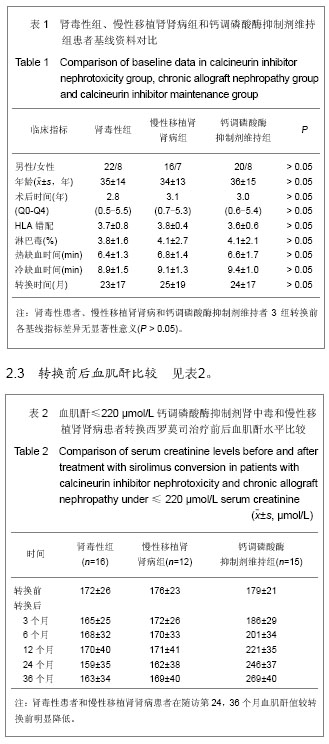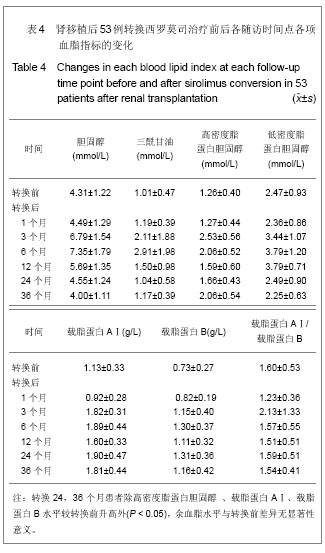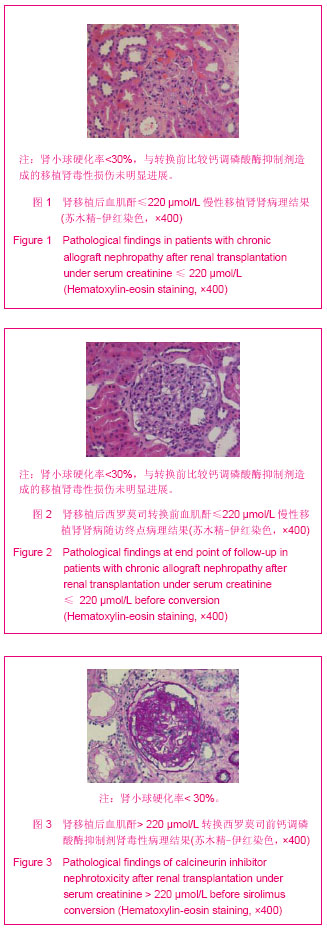| [1] LiL,Sun Q.Renal transplantation in China:ten years of experience at Nanjing Jinling Hospital.Clin Transpl.2006: 71-77.[2] Tomasoni S.Remuzzi Q Benigni A.Allograft rejection:acute and chronic studies.Contrib Nephrol.2008;159:122-34.[3] 季曙明,文吉秋,黎磊石,等.西罗莫司对肾移植受者的转换治疗[J]. 中国组织工程研究与临床康复,2009,13(31):6018-6022.[4] De Mattos AM,Olyaei AJ,Bennett WM.Nephrotoxicity of immunosuppressive drugs:long-term consequences and challenges for the future.Am J Kidney Dis.2000:35(2): 333-346.[5] 文吉秋,季曙明.雷帕霉素减轻神经钙蛋白抑制剂的肾毒性[J].肾脏病与透析肾移植杂志,2007,16(3):283-288.[6] Saber LT,Ikeda MY,Almeida JM.Posttransplantation conversion to sirolimus-based immunosuppression:a single center experience Transplant Proc,2007,39:3098-3100.[7] Racusen LC, SolezK, Colvin RB, et al.The Banff 97 working classification of renal allograft pathology.Kidney Int.1999;55 (2): 713-723.[8] 丰贵文,李金锋,王跃,等.西罗莫司替换钙调磷酸酶抑制剂治疗老年亲属供肾移植受者移植肾功能减退的疗效[J].器官移植,2011, 2(4):194-196.[9] Ji SM,Li LS,Wen JQ,et al.Therapeutic effect of Tripterygium wilfordii on proteinuria associated with sirolimus in renal transplant recipients.Transplant Proc.2008;40(10):3474-3478.[10] 中华心血管病杂志编委会.血脂异常防治建议[J].中华心血管病杂志,1997,25(3):169-175.[11] Yates PJ,Nicholson ML.The aetiology and pahogenesis of chronic allograft nephropathy.Transplant Immunol.2006; 16: 148-157.[12] Nankivell BJ,Borrows RJ,Fung CL,et,al.Calcineurin inhibitor nephrotoxicity:Iongitudinal assessment by protocol histology. Transplantation,2004,78:557-565.[13] Nankivell BJ, Borrows RJ, Fung CL,et al.Calcineurin inhibitor nephrotoxicity:longitudinal assessment by protocol histology. Transplatation,2004,78(4):557-565.[14] Helal I,Chan L.Steroid and calcineurin inhibitor-sparing protocols in kidney transplantation.Transplant Proc,2011; 43(2): 472-477.[15] Diekmann F,Campistol JM.Covension from calcineurin inhibitor to sirolimus in chronic allograft nephropathy:benefits and risks.Nephrol Dial Transplant.2006;21(3):562-568.[16] Diekmann F,Badde K,Oppenhermer F,et al.Predictors of success in convension from calcineurin inhibitors to sirolimus in chronic allografl dysfunction.AM J Transplantation. 2004; 4(11):1869-1875.[17] Weber T,Abendroth D,Schelzing H.Rapamycin rescue therapy in patients afrer kidney transplantation:first clinical experience.Transpl Int.2005;18(2):151-156. [18] Bumbea V,Kamar N,Ribes D,et al.Long-term results in renal transplant patients with allcgraft dysfunction after switching from calcineurin inhibitors to sirolimus.Nephrol Dial Transplant. 2005;20(11):2517-2523.[19] Bosmans JL,Ysebaert DK.Verpooten GA.Chronic allograft nephropathy:what have we learned from protocol biopsies?Transplantation.2008;85(7 Supl):S38-S41.[20] Citterlo F,Scata MC,Violi P,et al.Rapid conversion to sirolimus for chronic progressive deterioration of the renal function in kidney allograft recipients. transplant:Proc.2003; 35(4): 1292-1294.[21] Coombes JD,Mreich E,Liddle C,et al.Rapamycin worsens renal function and intratubular cast formation in protein overload nephropathy.Kidney Int.2005;68(6):2599-2607.[22] Letavernier E,Peraldi MN,Pariente A,et,al. Proteinuria following a switch from calcineurin inhibitor to sirolimus. Transplantation.2005;80(9):1198-2203.[23] Arellano EM,Campistol JM,Oppenheimer F,et al.Sirolimus monotherapy as maintenance immunosuppression: single-center experience in 50 kidney transplant patients. Transplant Proc.2007;39(7):2131.2134.[24] 惠氏专栏.310试验中早期使用西罗莫司并撤除环孢素A并不导致蛋白尿增加[J].中华器官移植杂志,2008,29(7):448.[25] MacDonald AS ,for the Rapamune Global Study Group.A worldwide phaseⅢrandomized,controlled,safety and efficacy study of a sirolimus/cyclosporine regimen for prevention of acute rejection in recipients of primary mismatched renal allografts.Transplantation.2001;71:271.[26] 曾章新,谭建明.肾移植患者血脂紊乱对移植肾功能的影响[J].国外医学泌尿系统分册,2005,32:217-220.[27] Asberg A,hartmann A,Fjeldsa E,et aI. AtorvGOTatinimproves endothelial function in renal transplant recipients.Nephrol Dial Transplant.2001;16:19-20.[28] 叶平.血脂的基础与临床[M].北京:人民军医出版社,2002:205.[29] 王长希,尚文俊,陈立中,等.雷帕霉素对肾移植受者血脂的影响[J].肾脏病与透析肾移植杂志,2004,13(3):222-225.[30] MacDonald A,Scarola J,BurkeJT,et al.Clinical pharmacokinetics And the rapeutic drug monitoring of sirolimus. Clin Ther.2000;22 (suppl B):101-121.[31] 陆莉,林志彬.一种新型的免疫抑制剂——雷帕霉素[J].中国药学杂志,2001,36(9):643-545.[32] 季曙明,文吉秋,沙国柱,等.西罗莫司对肾移植受者的转换治疗[J].中国组织工程研究与临床康复,2009,13(31):6018-6022. |






.jpg)